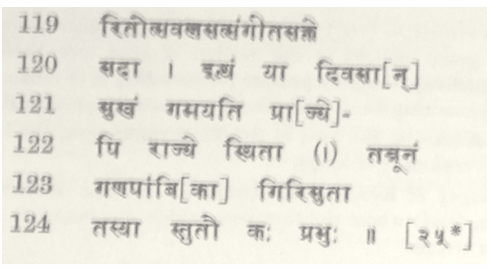|
The Indian Analyst
|
North Indian Inscriptions |
YENAMADALA INSCRIPTION OF GANAPAMBA.
TRANSLATION. ......(Verse 1.) Worship ye incessantly the sun (which dispels) the darkness of obstacles, the blessed Gaṇêśa, who is praised by the hosts of celestials, pleased by the attainment of the objects of (their) desires (through his favour) ! ......(V. 2.) Victorious is the staff-like tusk of Vishṇu, who disported himself in the shape of a boar, (placed) on which (tusk) the Earth resembled a parasol, with the golden mountain (Mêru) as its top. ......(V. 3.) Hail ! Renowned in the world is the race of the glorious Kâkatîśas, the kings born in which are well trained in the protection of the earth.
......(V. 4.) In this (race) was (born) Prôla, the foremost among kings, whose great valour was widely known, who destroyed the crowd of (his) enemies in soldierlike fights,1 (and) who was distinguished by the true science of policy. Even now, the hot-rayed sun is moving on the sky as though it were a fragment of the brilliant lustre of his great, far-famed and terrible power. ......(V. 5.) To this favourite of the earth (Mahîvallabha) was born a mountain of virtues (and) resort of the fortunes of heroes, king Mâdhava, whose great and spotless fame was celebrated in the world. Having fallen asleep in a great battle on the two temple of a female elephant, this foremost among warriors awoke on the two breasts of a distinguished nymph of heaven.2 ......(V. 6.) His son was king Gaṇapati, the ornament of the three worlds (and) resting-place of wisdom, who was an adherent of Non-duality (Advaitavâdin) with respect to valour;3 who was fierce in (his) commands, which (he) caused to dance on the crowns of proud crest-jewels among princes ; who had obtained great prosperity through the favour of (Śiva) the lord of Pârvatî ; (and) who supported all men with the wealth of the (whole) world, (which he had) conquered. ......(V. 7.) The foremost among kings (is) that ornament of princes, the glorious Gaṇapa, to whose fame all the regions are attendants ; the oceans,― tanks for sporting ; (Mount) Mêru,― a pleasure hill ; (Indra’s garden) Nandana,― a splendid park ; yonder disc of the moon,― a looking-glass ; and the interval between heaven and earth,― a palace. ......(V. 8.) To this profound king, who resembled the milk-ocean,4 was born Gaṇapâmbâ, like another Lakshmî incarnate. ......1 The author appears to have formed the word paripara on the basis of pariparin, ‘an enemy.’ which is
referred to the by Pâṇini, v. 2. 89.
| ||||||||||||||||||||||||||||||||||||||||||||||||||||||||||||||||||||||||||||
| > |
|
>
|








